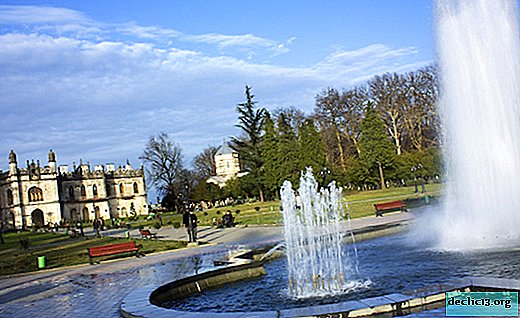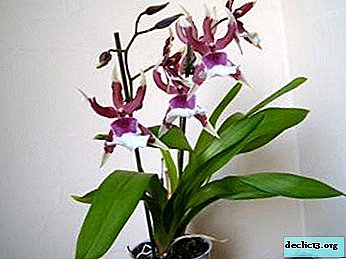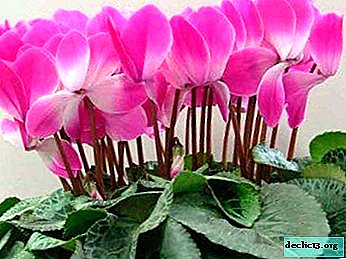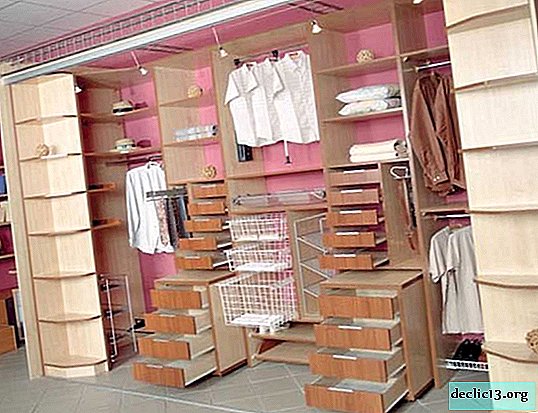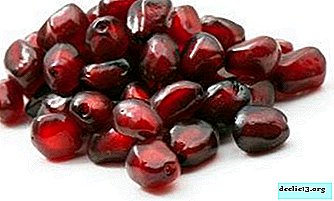What if petunia does not bloom? Why is this happening and what needs to be changed in care?
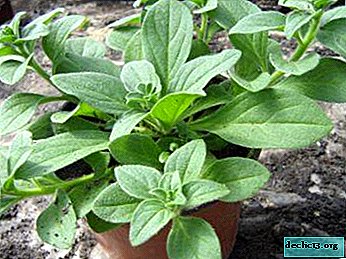
Petunia is one of the most beloved plants of modern gardeners. Not every flower can boast such an abundance of bright colors and a variety of varieties.
But for the petunia to bloom profusely and for a long time you need to make an effort. Starting with seed selection and ending with care throughout the entire period of life.
Why these beautiful plants do not bloom on the balcony or in other conditions and how to deal with this, as well as what should be the care of such popular flowers, we will tell in this article.
What is this plant?
Petunia is a semi-shrubby herbaceous plant of the nightshade family. She comes from South America. The plant has a powerful root system. Leaves are rounded, green. The stems are erect or creeping.
 According to the size of the bush, petunias are:
According to the size of the bush, petunias are:
- tall;
- dwarf.
By flower size:
- large-flowered;
- multi-flowered.
Leaves and stems of the plant are covered with small villi, single funnel-shaped flowers. The flowers consist of five petals and can be from 5 to 15 cm in diameter.
Depending on the variety, the edges of the flowers can be smooth, wavy or corrugated. The color of flowers is very diverse from white to black. The richest and most beautiful flowers are obtained in the hottest and driest summers.
Heat and light are the most important condition for a good flowering of petunias. Budding begins 70-80 days after emergence. And flowering - from mid-April to the first frost (depending on the variety).
Attention! If you grow petunia from seeds, you can transfer it to a cooler place at the end of March. This will help to bookmark more buds. In this case, flowering will be somewhat delayed in time.What to do if it blooms poorly or this does not happen at all?
Causes of poor flowering and their elimination:
- Too small pot. Since petunia has a fairly powerful root system, it needs room. One bush should have at least two liters of soil (minimum), and for some varieties - up to 10 liters. The solution is simple - thin out the plants. In order for the plants not to suppress each other, the distance between them should also be at least 15-20 cm. Also, pots should not be placed close to each other.
- Low light. Petunias are photophilous plants and if they are planted in a place where there is not enough light, then flowering will be weak, and may not occur at all. Flowers will be small and dull, their number will be less. The most suitable place is an open sunny area.
- Incorrect feeding. To build green mass of petunia requires nitrogen, and for flowering - potassium. If during fertilizing nitrogen fertilizers constantly prevail, then the plant will use all its forces to build up shoots and leaves. The second mistake is insufficient feeding or its absence at all. Petunia loves to eat. And it should be fed at least once a week. You can find out how to feed petunia for abundant flowering here.
- Unsuitable soil. Poor and dense soil is completely unsuitable for petunias. In such a land, flowering will be sparse, and the plant will be weak. The soil should contain peat and some sand. And it is very desirable to add a baking powder (perlite or vermiculite) to it.
Why did the plant stop flowering?
Diseases and pests:
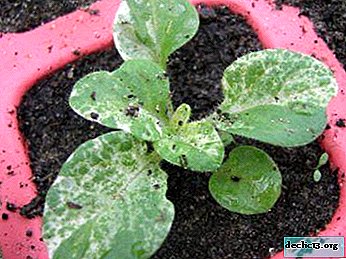 Powdery Mildew It manifests itself in the fact that the lower leaves of the plant are covered with white coating and have a specific smell. Then they fade, twist and fall. Petunia, affected by powdery mildew, not only does not bloom, it stops its growth and dies. Here, such drugs as Topaz, Topsin-M, Sulfaride will come to your rescue.
Powdery Mildew It manifests itself in the fact that the lower leaves of the plant are covered with white coating and have a specific smell. Then they fade, twist and fall. Petunia, affected by powdery mildew, not only does not bloom, it stops its growth and dies. Here, such drugs as Topaz, Topsin-M, Sulfaride will come to your rescue.- Whitefly This insect will hit the attacker on the plants and feed on its juice. If the damage to the plant by this pest is not noticed in time, the plant will die. You can deal with whiteflies using suitable insecticides, such as Actar or Fitoverim. There are also traps, fumigators, sprays for pain with this pest.
- Spider mite - one of the most dangerous pests. He also eats the juice of the plant, which can lead to his death. Petunia, affected by a spider mite, does not bloom and soon dies. Insecticidal preparations for combating spider mites: Neoron, Fitoverm, Actellik. You can also spray the plant with a soap solution or infusion of onion husks.
- Aphid. This pest is also very dangerous for petunias. Aphids - a carrier of many viral diseases from which petunia suffers. Parts of the plant affected by aphids are covered with honey dew (the product of vital activity of aphids). In turn, honey dew provokes the appearance of fungal diseases. Parts of the plant twist and fade, if there are buds or flowers, then they dry up and fall off.
What should be the care?
Care to ensure the flowering of petunias includes:
- Watering.
- Top dressing.
- Pinch and trim.
- Stimulation of flowering (if necessary).
Proper watering
Although petunia loves heavy watering, you can’t fill it. It is advisable to water the plant in the morning and evening. In this case, the water should be clean, settled and room temperature. The most dangerous is the stagnation of water in the soil. This can cause not only poor flowering, but also root disease and death. In dry and hot weather it is very advisable to spray the petunia from the spray gun. Moreover, the water should be warm.
Attention! If the nights are cool, it is not recommended to water the petunia late in the evening to avoid hypothermia and root disease.Top dressing
Proper nutrition includes several stages:
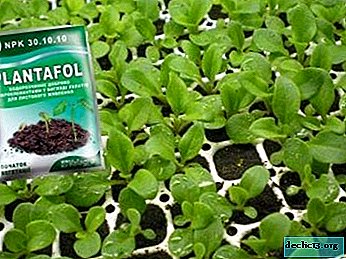 Succinic acid seed treatment. It affects growth and flowering. Immunity increases, the plant easily assimilates nutrients from the soil.
Succinic acid seed treatment. It affects growth and flowering. Immunity increases, the plant easily assimilates nutrients from the soil.- Fertilizing the substrate before planting. This creates a good environment for the plant, the prophylaxis of the disease is a black leg.
- Phosphate fertilizer - after the beginning of flowering, the plant should be fed with them at least 1 time per week.
- Foliar fertilizer. Apply to the leaves and stems of the plant using a spray gun. This helps to better absorb nutrients. It is advisable to alternate foliar and root dressing.
- Potash fertilizers. Such top dressing will change immediately before flowering. But it should be remembered - the presence of potassium can inhibit growth, and its excess will lead to death.
Petunia should be fertilized throughout the entire period of its life, starting from 14 days after planting. Fertilizer must be comprehensive.
Pruning and pinching
Nipping is performed at the seedling stage. After the appearance of a 5-6 leaf, the tip of the shoot is cut off. Pruning is done already at the adult plant stage. It promotes the formation of large flowers, increase their number, extend the flowering period. It is necessary to remove not only dead flowers, but also elongated stems and dry leaves. For best results, remove up to a third of the shoot.
The procedure is recommended to be carried out once every two weeks. Thanks to this, the plant is updated, quickly restored, blooms profusely.
Fertilizers for stimulation
The most powerful stimulants are potash fertilizers. Since it is the potassium content in the soil that contributes to the laying of larger buds. Feeding can be carried out with individual substances such as:
- urea;
- calcium nitrate;
- potassium monophosphate.
Complex fertilizers, such as:
- Crystal
- Scots.
- Plantophilus for foliar top dressing.
- Planton S.
Be sure to study the instructions for the use of fertilizer. And apply strictly following the instructions. Top dressing is carried out according to the scheme: watering - top dressing - watering - top dressing.
Attention! If you apply fertilizers every other day, their concentration should be reduced by a factor of three. If fertilizers are applied once a week, then the composition should be diluted according to the instructions.We described in more detail about feeding petunias to stimulate flowering here, and from this article you will learn how to care for a plant when it blooms.
Quality care is always a set of activities. The choice of seeds, seedlings, top dressing, watering - all this is important.
Do not think that it is enough to water the petunia several times with fertilizer, and it will bloom all season. Each step should be taken seriously, scrupulously and carefully. And you will certainly get the result.

 Powdery Mildew It manifests itself in the fact that the lower leaves of the plant are covered with white coating and have a specific smell. Then they fade, twist and fall. Petunia, affected by powdery mildew, not only does not bloom, it stops its growth and dies. Here, such drugs as Topaz, Topsin-M, Sulfaride will come to your rescue.
Powdery Mildew It manifests itself in the fact that the lower leaves of the plant are covered with white coating and have a specific smell. Then they fade, twist and fall. Petunia, affected by powdery mildew, not only does not bloom, it stops its growth and dies. Here, such drugs as Topaz, Topsin-M, Sulfaride will come to your rescue. Succinic acid seed treatment. It affects growth and flowering. Immunity increases, the plant easily assimilates nutrients from the soil.
Succinic acid seed treatment. It affects growth and flowering. Immunity increases, the plant easily assimilates nutrients from the soil.
